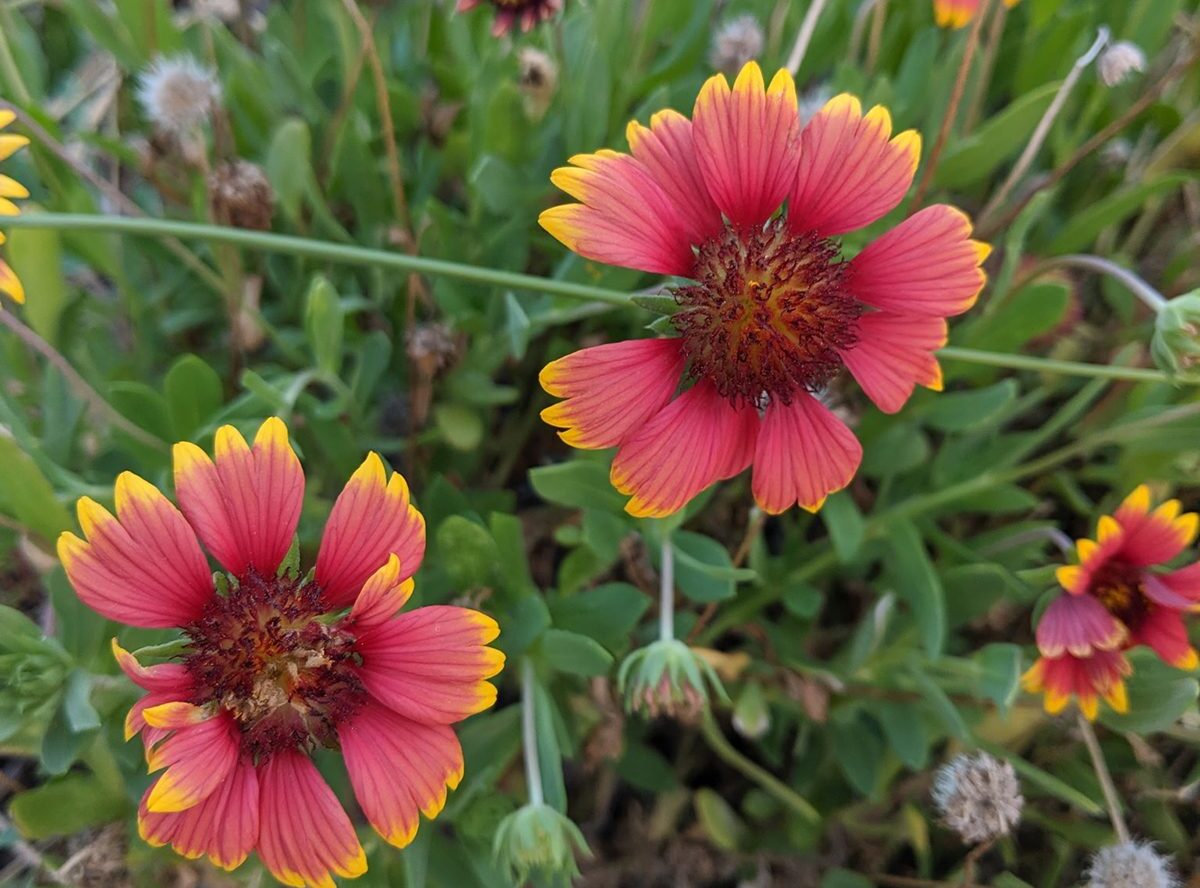A popular meme circulating on social media proclaims, “You don’t stop gardening when you get old, you get old when you stop gardening.”
Come to think of it, a lot of the most impressive landscapes I visit in the course of my job as a garden writer/author are tended by green-fingered folks who are seniors. Falling in that age category myself, I want to be able to garden for as long as I can.
As I’m writing this from my front porch (aka my outdoor office) in south Minneapolis, I can see my neighbor Donna Hamilton, 10 years my senior, working in her yard across the street — mowing, raking, watering, planting and weeding. She puts me to shame with her impressive efforts. Then, the now-retired designer gets in her car and drives to her second garden at her studio a few miles away.
“When I’m gardening I can get lost in time, a half-hour becomes two and half. I spend a lot of time planning and envisioning, it’s almost like an artwork,” Hamilton said. “The garden requires all my attention, so I’m released from daily concerns.”
It got me thinking, how do gardeners extend their years enjoying one of their favorite pastimes as we become less sprightly and more prone to aches and injuries? From the 20-20-20 rule to vertical gardening, health experts and gardeners share advice worth digging into.
Mind-body connection
The health benefits of gardening are widespread. According to a National Library of Medicine study, gardening can help prevent osteoporosis as well as reduce the risk of some cancers, heart disease and more.
Beyond the health benefits, Donna and I agree the thing we enjoy most is the escape, watching the small wonders that occur almost daily in our garden landscapes.
According to Sarah Kottke Palm, Minnesota Landscape Arboretum program specialist for nature-based therapeutics, the scientific term for this is biophilia. As humans, it’s part of our innate, genetic disposition to connect with plants and nature.
It’s “based on meaningful experiences that emotionally bond us to, and establish a love of, nature,” she said. “Experiencing awe and wonder in our gardens can contribute to a host of benefits, including an expanded sense of time and enhanced feelings of generosity, well-being and humility.”
However, Donna and I also compare notes about the physical toll our favorite hobby takes on our bodies. Sometimes I find myself after a long day in the garden — with my aching muscles screaming— asking if gardening is making me stronger or hurting me.
To that end, Donna and I both see a personal trainer twice a week who puts us through exercises — some specifically catering to our garden chores. Jacquelyn Hauser is certified through the National Academy of Sports Medicine and specializes in corrective exercise, senior fitness and behavior modification. Just as important for us, she is 70 and an Extension Master Gardener, so she understands our world.
“Gardening is so great because there is variety of movement,” Hauser said.
She emphasizes preparing for the growing season by staying active during winter. Hauser likens it “to vigorously brushing your teeth for only six months but expecting a healthy mouth all year long.”
She also recommends regular strength exercises through SilverSneakers or other wellness groups because people are more likely to stick with a communal program.
Hauser’s sessions include exercises such as reaching and pulling motions with resistance bands that mimic weeding. (Be sure to use your shoulder blades!) Donna said she especially enjoys a high-step balance maneuver that recreates the movement of steadily stepping back and forth over perennials in her garden beds. She feels this has helped her feel more firmly planted while she’s gardening.
Hauser also stressed the importance of stretching before gardening. “Don’t start cold,” she said. “Maybe go for a walk, do some sit-stand repetitions, move your arms and shoulders.”
Here are additional tips to make gardening easier as you age:
Re-think your garden strategy
Toni Gattone, author of “The Lifelong Gardener,” recommends re-evaluating your garden. “Walk through your garden. Are there vertical gardening opportunities that can elevate your garden beds? Consider elevated waist-high raised beds, wall planters, window baskets, arbors, and trellises that will allow you to stand up to plant, tend and harvest with greater comfort,” Gattone said.
She also advised tasks in 20-minute increments to avoid repetitive movements that can cause pain.
“The 20-20-20 rule helps you remember to do one chore, like raking or sweeping, for 20 minutes, then put down those tools, and get down on your knees to do some weeding,” Gattone said. “After about twenty minutes, switch chores, and use different muscles, to stand up to prune your favorite flowering shrub. Don’t wait for your body to tell you to switch.”
Plant in a whole new light
From my experience, in-ground annuals planted every year are labor-intensive. So as you age, consider switching to large containers. Perennials don’t need replanting but they do need deadheading, cutting back and dividing — so perhaps replace them with small flowering shrubs that require less maintenance.
On the subject of shrubs, it’s worth noting that breeders have responded to the call for more compact plants for small-space gardens. Today there are countless options and many new versions of old favorites like lilac, hydrangea, mock orange and spirea, just not so big. Plant them in mass for the same effect of perennials without the work.
Go vertical
Every bit you don’t have to bend makes planting, weeding and watering less troublesome. In my veggie garden, I grow vertically whenever I can. Trellises and tall supports are your friends, making picking tomatoes, pole beans, peas, cucumbers, vining squash and mini-melons easier. Not only are they simpler to harvest and take up a smaller footprint, but the improved air circulation prevents many fungal diseases.
Elevated planter beds have come on the scene in a big way, in all sorts of colors and materials sure to match your garden aesthetic. They come in two heights for either sitting or standing. They’re large enough to grow an assortment of attractive annuals or herbs and salad fixings, some can fit a few larger veggies like tomatoes or eggplants. Some elevated beds can accommodate wheelchairs making gardening more accessible to everyone.
Embrace ergonomic tools
Ergonomic tools can help, especially with garden chores involving repetitious motion. Softer handles can offer relief from arthritis. Nozzle sprayers with a front-pull lever are gentler than a back-pull lever. Rakes, hoes and shovels with padding on handles help reduce blisters and hand fatigue. Long-handled hoes and weeders mean less bending.
Donna and I find that using kneeling pads is essential for hard surfaces and tender knees. Donna said using a softer one is a game-changer for her, while I prefer to use two at a time, shuffling one in front of me as I go to avoid getting up and down so many times as I weed along the edges. There are also versatile padded kneeling benches that, when flipped over, double as a small seat for when you are working close to the ground.
Lighten the load
New polyurethane hoses are super lightweight making them less of a drag to move around the garden and simpler to coil when you’re finished. A bonus — they aren’t as damaging when they run over plants.
I go one step further and use expandable hoses that shrink when not in use. Sure, I have to be more careful they don’t snag and tear on things but they are perfect for my veggie garden.
Skip the back-and-forth trips by carrying all your tools in a single bucket or compact tool organizer or, better yet, a mobile tool caddy. Most have sturdy rubber tires that can handle varying terrain. Many feature an extra container for weeds and plant debris too. Or, put yourself on wheels with a tractor scoot and roll while you work, minimizing strain on your knees and back.
Last but not least, carry your cellphone for that one time you may need help.
Rhonda Hayes is a Twin Cities-based Extension Master Gardener, writer and author of “Pollinator Friendly Gardening.”










